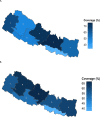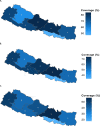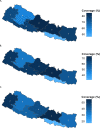Age-appropriate vaccination coverage and its determinants in children aged 12-36 months in Nepal: a national and subnational assessment
- PMID: 34758802
- PMCID: PMC8582094
- DOI: 10.1186/s12889-021-11841-2
Age-appropriate vaccination coverage and its determinants in children aged 12-36 months in Nepal: a national and subnational assessment
Abstract
Background: Vaccination is one of the effective ways to develop immunity against potential life-threatening diseases in children in early age. This study is focused on analysing the age-appropriate vaccination coverage at national and subnational levels and identify the factors associated with age-appropriate coverage in Nepal.
Methods: 460 children aged 12-36 months were included in the study. The data was obtained from Nepal Demographic and Health Survey (NDHS) 2016-17. Age-appropriate coverage of Bacillus Calmette-Guerin vaccine (BCG), oral polio vaccine (OPV) doses 1-3, pentavalent vaccine (PE) doses 1-3, and first dose of measles, mumps, and rubella vaccine (MMR) were estimated using Kaplan Meier method. Multilevel logistic regression with random intercept was used to identify the factors associated with age-appropriate vaccination.
Results: The crude coverage of the vaccines included in the study ranged from 91.5% (95% CI, 88.5-93.7) for PE3 to 97.8% (95.8-98.7) for BCG. Although the crude coverage of all the vaccines was above 90%, the age-appropriate coverage was significantly low, ranging from 41.5% (36.5-46.6) for PE3 to 73.9% (69.2-78.1) for PE1. Furthermore, high disparity in timely vaccination coverage was observed at regional level. Compared to the age-appropriate vaccination coverage in other provinces, Province 2 had the lowest coverage of all, followed by that in Province 6. The timeliness of vaccination was significantly associated with subnational regions i.e., provinces and the season of childbirth.
Conclusion: Although the immunization program in Nepal has achieved the target of 90% crude coverage of all the childhood vaccines, the age-appropriate coverage is significantly low which undermines the effectiveness of the vaccines administered. Thus, along with crude coverage, timeliness of the vaccines administered should be taken into consideration and thoroughly monitored at national and subnational levels. Provincial government should formulate tailored strategies to ensure the timely administration of the childhood vaccines.
Keywords: Delay; Immunization; Timeliness; Vaccination; Vaccine coverage.
© 2021. The Author(s).
Conflict of interest statement
The authors have declared that no competing interests exist.
Figures





Similar articles
-
Timeliness of routine vaccination among children and determinants associated with age-appropriate vaccination in Mongolia.Heliyon. 2020 Sep 18;6(9):e04898. doi: 10.1016/j.heliyon.2020.e04898. eCollection 2020 Sep. Heliyon. 2020. PMID: 32995607 Free PMC article.
-
Infant vaccination timing: Beyond traditional coverage metrics for maximizing impact of vaccine programs, an example from southern Nepal.Vaccine. 2016 Feb 10;34(7):933-41. doi: 10.1016/j.vaccine.2015.12.061. Epub 2016 Jan 11. Vaccine. 2016. PMID: 26788880 Free PMC article. Clinical Trial.
-
Routine childhood vaccination programme coverage, El Salvador, 2011-In search of timeliness.Vaccine. 2014 Jan 16;32(4):437-44. doi: 10.1016/j.vaccine.2013.11.072. Epub 2013 Dec 4. Vaccine. 2014. PMID: 24315884
-
Beyond Vaccination Coverage: Population-Based Measurement of Early Childhood Immunization Schedule Adherence.Acad Pediatr. 2023 Jan-Feb;23(1):24-34. doi: 10.1016/j.acap.2022.08.003. Epub 2022 Aug 20. Acad Pediatr. 2023. PMID: 35995410 Free PMC article. Review.
-
The impact of COVID-19 and catch-up strategies on routine childhood vaccine coverage trends in Latin America: A systematic literature review and database analysis.Hum Vaccin Immunother. 2022 Nov 30;18(6):2102353. doi: 10.1080/21645515.2022.2102353. Epub 2022 Sep 9. Hum Vaccin Immunother. 2022. PMID: 36084255 Free PMC article.
Cited by
-
Vaccination Coverage and Adherence to Scheduling in Children Aged 0 to 18 Months: Effects of COVID-19 and Age.Vaccines (Basel). 2025 Apr 3;13(4):387. doi: 10.3390/vaccines13040387. Vaccines (Basel). 2025. PMID: 40333246 Free PMC article.
-
Evaluating active leprosy case identification methods in six districts of Nepal.Infect Dis Poverty. 2023 Dec 6;12(1):111. doi: 10.1186/s40249-023-01153-5. Infect Dis Poverty. 2023. PMID: 38053215 Free PMC article.
-
Coverage and determinants of childhood vaccination during the COVID-19 pandemic in Fortaleza, Northeastern Brazil: a longitudinal analysis.Cad Saude Publica. 2024 Feb 2;40(1):e00074723. doi: 10.1590/0102-311XEN074723. eCollection 2024. Cad Saude Publica. 2024. PMID: 38324862 Free PMC article.
-
Effective coverage of child immunisation service in Ethiopia.Sci Rep. 2025 May 29;15(1):18938. doi: 10.1038/s41598-025-02885-0. Sci Rep. 2025. PMID: 40442111 Free PMC article.
References
-
- National Center for Immunization and Respiratory Diseases, CDC. Vaccines and Prevantable Diseases. 2016. https://www.cdc.gov/vaccines/vpd/index.html (accessed August 2020).
-
- Keja K, Chan C, Hayden G, Henderson RH. Expanded programme on immunization. World Health Stat Q. 1988;41(2):59–63. - PubMed
-
- World Health Organization. Immunization Coverage 2020. https://www.who.int/news-room/fact-sheets/detail/immunization-coverage (accessed 10 September, 2020).
Publication types
MeSH terms
Substances
LinkOut - more resources
Full Text Sources

